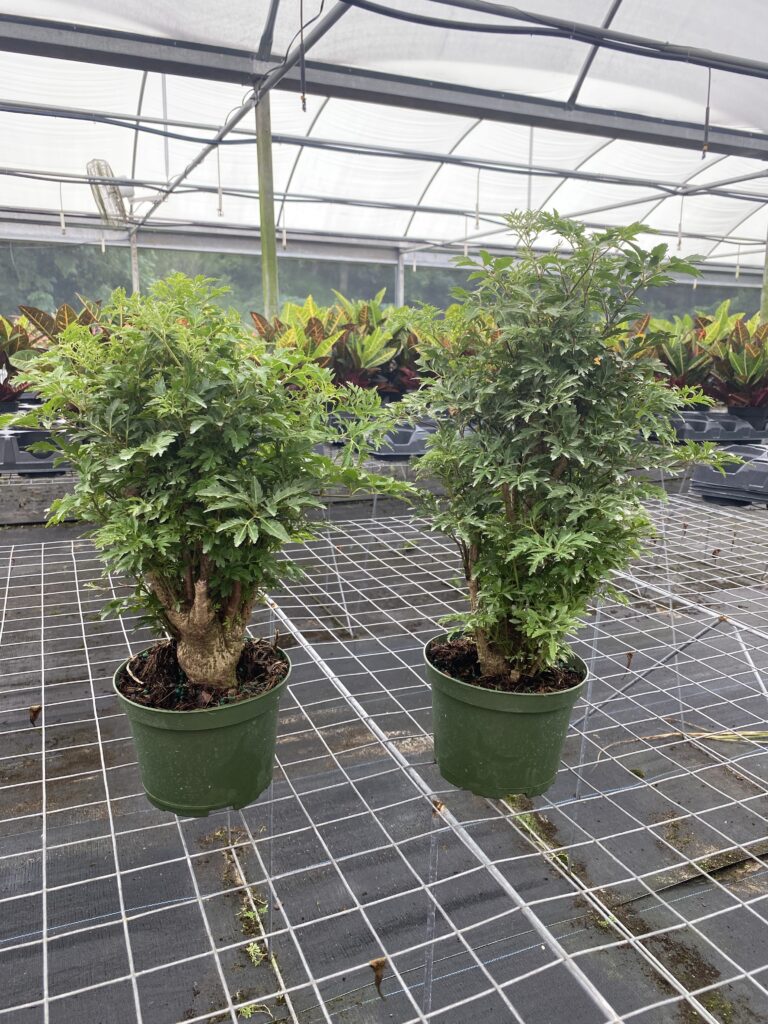
Ming Aralia, or Polyscias fruticosa, is a striking houseplant known for its unique foliage and elegant appearance. It’s often admired for its feathery, deeply lobed leaves and its ability to grow into a visually appealing small tree or shrub.
We carry Ming Aralia plants in 6″ pots.
Here’s a detailed guide to caring for Ming Aralia.
Appearance
Growth: It can grow to 2-4 feet tall indoors, with a similar spread. In its natural habitat or larger containers, it can become quite bushy and tree-like.
Leaves: Ming Aralia has attractive, glossy, dark green leaves that are finely divided, giving them a delicate, feathery appearance. The leaves are typically arranged in a rosette pattern along the stems.
Care Tips
Light: Prefers bright, indirect light. It can tolerate lower light conditions but will grow more slowly and might become leggy. Avoid direct sunlight, which can scorch the leaves.
Watering: Keep the soil consistently moist but not soggy. Water when the top inch of soil feels dry. Overwatering can lead to root rot, so ensure the pot has good drainage. Reduce watering in winter when the plant’s growth slows.
Soil: Use a well-draining potting mix. A standard houseplant mix or a blend designed for tropical plants, with added perlite or sand, works well.
Temperature: Thrives in temperatures between 60-75°F (15-24°C). It prefers a stable temperature and should be protected from drafts and sudden temperature changes. Avoid temperatures below 50°F (10°C).
Humidity: Ming Aralia enjoys higher humidity but can adapt to average indoor conditions. Increasing humidity with a humidity tray or occasional misting can be beneficial, especially in dry climates or during winter.
Fertilizing: Feed with a balanced, water-soluble fertilizer every 4-6 weeks during the growing season (spring and summer). Reduce feeding in the fall and winter when growth slows.
Repotting: Repot every 1-2 years or when the plant becomes root-bound. Spring is the ideal time for repotting. Choose a pot that is slightly larger than the current one to accommodate growth.
Pruning: Prune to shape the plant and remove any dead or damaged leaves. Regular pruning can help maintain a compact and bushy growth habit.
Pests and Problems: Ming Aralia is relatively pest-resistant but can occasionally face issues with pests like spider mites, mealybugs, or scale. Check the plant regularly for signs of pests and treat as needed. Yellowing leaves can indicate overwatering, poor drainage, or a lack of nutrients.
Additional Tips
Air Circulation: Good air circulation around the plant can help prevent issues like fungal infections and pests.
Toxicity: Ming Aralia is generally considered non-toxic to pets and humans, making it a safe choice for homes with animals and children.
If you have any questions, or are interested in purchasing, feel free to come by the nursery or give us a call at (352)735-8350. Our inventory is also available to see online.
